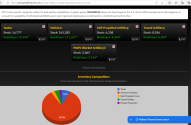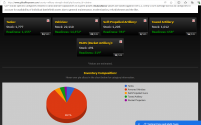Writer Justin Bronk from the think tank RUSI emphasized the problem for Ukraine's F-16 pilots: they will have to fly low to survive – and that impedes the use of the missiles.
The main problem highlighted is ground-based air defenses, which make it extremely dangerous for Ukrainian combat aircraft to fly at high altitudes practically anywhere in Ukraine – but especially around 160 km from the front line, well within range of the S-400s. .
While it is possible that Ukraine is acquiring 100-mile-range AIM-120D air-to-air missiles for its F-16s, apparently allowing Ukrainian pilots to fire at Russian bombers from the edge of Russian air defense coverage – in practice, o AIM-120s will fall short of their full range.
Here is what he states:
Fired at low altitude, an AIM-120 potentially loses tens of km of its range, possibly putting Russian bombers out of range – unless Ukrainian pilots can somehow fly deep into Russian-controlled territory and survive long enough. to fire your missiles.
As Bronk pointed out, a possible solution to this problem is a longer-range air-to-air missile, like the European Meteor, which flies up to 200 km in optimal conditions. But the Meteor is incompatible with the F-16 – and also incompatible with the Mirage 2000-5 fighters that France promised Ukraine. But the only type of fighter that Ukraine can acquire that can also carry the Meteor is the Swedish JAS39 Gripen. Stockholm has expressed its willingness to donate surplus Gripens to Ukraine – but has also agreed to suspend any transfers until the Ukrainians have finally received their first shipments of F-16s.
Ukraine's allies are apparently worried about overwhelming the Ukrainian air force with too much new equipment, too quickly.
So if Bronk's assessment is correct, it could be some time – a year or more – before Ukraine has a fighter-missile combination that can shoot down Russia's glide bomber bombers without also exposing Ukrainian pilots to risk. extremes.
This helps explain the emphasis Ukraine has placed on attacking Russia's Sukhois and KAB arsenals while they are on the ground. Ukraine's long-range attack drones hitting the air bases that Sukhoi take off and land from is just one more alternative without exposing Ukrainian pilots and fighters to the heightened risk of interception.
Basically even with the F-16, Ukraine will have a long challenge in establishing a comparative advantage in the air over the VKS because of restricted flight altitude conditions on the front line. A fast-flying Sukhoi Su-34 can deliver a glide bomb at distances of up to 40 km – or up to 64 km in the case of newer, longer-range KABs. That's far enough away that Ukraine's existing air defenses won't always be able to react.Even when the long-awaited pan-European F-16s and later planned and fighters are delivered to Ukraine, the glide bomb sorties will be very challenging to intercept regularly. When close to the frontlines, Ukrainian pilots will have to fly them at very low altitudes to avoid being detected and shot down by layered Russian short-range SA-15 ‘Tor M1/2’, medium-range SA-11/17/27 ‘Buk’ and long-range SA-21 ‘Growler’ and SA-23 ‘Gladiator\Giant’ SAM systems. As a result, the AIM-120C AMRAAM air-to-air missiles carried by the F-16 and Gripen C, and the shorter-range MICA IR/RF missiles carried by Mirage 2000-5F, will struggle to reach Russian fighters at high altitudes and high speeds 60–70 km behind the lines. This is because at such low altitudes, the missiles start out in dense air with a lot of aerodynamic drag and must climb against gravity to reach the altitudes where their targets are. As a result, by the time their rocket motors burn out after the first few seconds of flight, they have not gained nearly as much speed or altitude as if they were launched from a fighter flying in the thin air at high altitudes and at supersonic speeds, and so only have a comparatively short effective range. Only the European Meteor missile is likely to have the practical range required, and of the three fighter options now publicly discussed for Ukraine, only the Gripen C can carry and launch it.
The main problem highlighted is ground-based air defenses, which make it extremely dangerous for Ukrainian combat aircraft to fly at high altitudes practically anywhere in Ukraine – but especially around 160 km from the front line, well within range of the S-400s. .
While it is possible that Ukraine is acquiring 100-mile-range AIM-120D air-to-air missiles for its F-16s, apparently allowing Ukrainian pilots to fire at Russian bombers from the edge of Russian air defense coverage – in practice, o AIM-120s will fall short of their full range.
Here is what he states:
Once they are close to the front lines, Ukrainian pilots will have to fly them at very low altitudes to avoid being detected and shot down by layered Russian [air defenses].
...
At such low altitudes, missiles start in dense air with a lot of aerodynamic drag and must climb against gravity to reach the altitudes where their targets are,” Bronk added. “As a result, by the time their rocket engines burn out after the first few seconds of flight, they have not gained as much speed or altitude as if they were launched from a fighter jet flying in thin air at high altitudes and at supersonic speeds.
Fired at low altitude, an AIM-120 potentially loses tens of km of its range, possibly putting Russian bombers out of range – unless Ukrainian pilots can somehow fly deep into Russian-controlled territory and survive long enough. to fire your missiles.
As Bronk pointed out, a possible solution to this problem is a longer-range air-to-air missile, like the European Meteor, which flies up to 200 km in optimal conditions. But the Meteor is incompatible with the F-16 – and also incompatible with the Mirage 2000-5 fighters that France promised Ukraine. But the only type of fighter that Ukraine can acquire that can also carry the Meteor is the Swedish JAS39 Gripen. Stockholm has expressed its willingness to donate surplus Gripens to Ukraine – but has also agreed to suspend any transfers until the Ukrainians have finally received their first shipments of F-16s.
Ukraine's allies are apparently worried about overwhelming the Ukrainian air force with too much new equipment, too quickly.
So if Bronk's assessment is correct, it could be some time – a year or more – before Ukraine has a fighter-missile combination that can shoot down Russia's glide bomber bombers without also exposing Ukrainian pilots to risk. extremes.
This helps explain the emphasis Ukraine has placed on attacking Russia's Sukhois and KAB arsenals while they are on the ground. Ukraine's long-range attack drones hitting the air bases that Sukhoi take off and land from is just one more alternative without exposing Ukrainian pilots and fighters to the heightened risk of interception.



